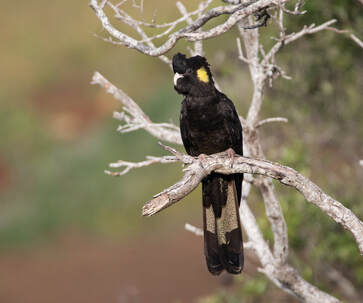Black Cockatoos at the Lake
If you’ve wandered down to the lake in recent months you’ve no doubt noticed the changes to the eastern side. It’s now a much safer place for families to enjoy the lake and relax on the grass amongst this attractively landscaped area. You may have also noticed Lennox Head Landcare volunteers engaging in the reestablishment and restoration of flora around the lake. We’ve literally planted hundreds of seedlings.
Our work involves removing invasive plants and replacing them with local natives that naturally occur around the lake foreshore. These plants adapt well to lake level rises and falls. We’ve also been working on the southern, western and northern shores (the latter to clear water hyacinth – more of that in a following article).
Retaining a healthy foreshore plant zone is crucial to maintaining a healthy lake. Plants filter and absorb nutrients before they enter the lake; they also assist in shoreline stability. A lot of these species are colourful groundcovers, reeds, rushes, sedges and creepers as well as the ubiquitous Paperbark and the lesser-known Swamp Oak.
The Swamp Oak (Casuarina glauca) thrives along the edge of lakes and the hind-dune wetlands along our coast and its seeds are an important food source for Yellow-tailed Black Cockatoos and Glossy Black Cockatoos.
You might have heard the Yellow-tails around Lennox lately. Their loud, melancholic wail is heard long before the flock is seen and a big flock in flight is something quite special to see. I counted 50 in a flock the other day. These are big, black birds with wingspans over a metre wide and splashes of yellow on their tail feathers. They have a distinctive, unhurried wing-beat and their continual raucous calls lend a surreal prehistoric feel to the languorous silhouette of shiny-black under sky-blue.
Black Cockatoos are common here in winter and spring because there’s plenty of food for them. Their food sources include seeds and pods of casuarina, banksia, hakea, wattle and eucalypts as well as introduced pinecones. Their large strong beaks also allow them to pry open branches in search of beetle and moth larvae; another important part of their diet.
Black Cockatoos nest in tree hollows, usually eucalypts, which can be a metre deep and 500mm wide. Trees with hollows this size are estimated to be 250-300 years old, that’s why it’s important to maintain old trees and old forests so birds like these and other fauna like possums, have plenty of places to breed.
By restoring and preserving habitat for plants and animals around the lake we’re also enhancing its surrounds for the community. So why not come along and join us on a Wednesday working bee? Together we can help keep the Lake a beautiful place for us all to enjoy.
Written by S Web, published June 2020.
Our work involves removing invasive plants and replacing them with local natives that naturally occur around the lake foreshore. These plants adapt well to lake level rises and falls. We’ve also been working on the southern, western and northern shores (the latter to clear water hyacinth – more of that in a following article).
Retaining a healthy foreshore plant zone is crucial to maintaining a healthy lake. Plants filter and absorb nutrients before they enter the lake; they also assist in shoreline stability. A lot of these species are colourful groundcovers, reeds, rushes, sedges and creepers as well as the ubiquitous Paperbark and the lesser-known Swamp Oak.
The Swamp Oak (Casuarina glauca) thrives along the edge of lakes and the hind-dune wetlands along our coast and its seeds are an important food source for Yellow-tailed Black Cockatoos and Glossy Black Cockatoos.
You might have heard the Yellow-tails around Lennox lately. Their loud, melancholic wail is heard long before the flock is seen and a big flock in flight is something quite special to see. I counted 50 in a flock the other day. These are big, black birds with wingspans over a metre wide and splashes of yellow on their tail feathers. They have a distinctive, unhurried wing-beat and their continual raucous calls lend a surreal prehistoric feel to the languorous silhouette of shiny-black under sky-blue.
Black Cockatoos are common here in winter and spring because there’s plenty of food for them. Their food sources include seeds and pods of casuarina, banksia, hakea, wattle and eucalypts as well as introduced pinecones. Their large strong beaks also allow them to pry open branches in search of beetle and moth larvae; another important part of their diet.
Black Cockatoos nest in tree hollows, usually eucalypts, which can be a metre deep and 500mm wide. Trees with hollows this size are estimated to be 250-300 years old, that’s why it’s important to maintain old trees and old forests so birds like these and other fauna like possums, have plenty of places to breed.
By restoring and preserving habitat for plants and animals around the lake we’re also enhancing its surrounds for the community. So why not come along and join us on a Wednesday working bee? Together we can help keep the Lake a beautiful place for us all to enjoy.
Written by S Web, published June 2020.




